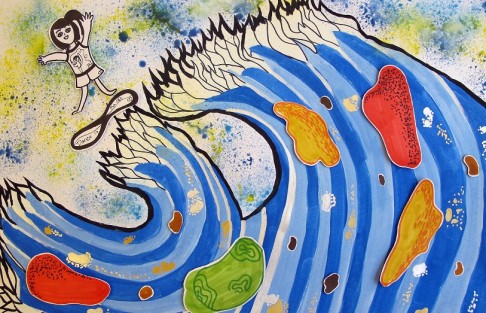
Chinese collector Nancy Mo aims to offer world-class art education in Hong Kong
Former investment banker has attracted heavyweight support for her art school in Wong Chuk Hang, where the teaching is in Putonghua - so students can improve their language skills too
They are the kind of art world heavyweights who would add legitimacy and gravitas to any creative project. Pi Li is a well-known critic and curator working at M+, Terry Huang is a former adviser to the Museum of Modern Art in New York and now runs an international art fund and Wallace Chan is a jewellery designer whose works have been shown in museums around the world.
All three have become honorary advisers of Y. Art, a private, Putonghua-only art school in Wong Chuk Hang for students between the ages of three and 18. An odd group, you might think, to show a close interest in an obscure project. But that's not taking into account the enthusiasm and sheer charisma of the school's founder Nancy Mo.
Huang and Chan wax lyrical about her. "I have known Nancy for many years and we've been close friends since before she married. She's a perfectionist and very passionate as an art collector. Her love of art is so strong she wants to transfer that spirit to an education platform, one that can pass knowledge on to the next generation," says Chan.
"The main reason I'm helping her is because she is one of my best friends," says Huang, managing partner and co-founder of Motif Art Group, a New York-based art investment firm.
"But I also believe with art education you don't just teach young people theory. They must learn to appreciate beauty, to enjoy what they are looking at. Nancy's school teaches that and I believe not many art schools do that," he says.
In person, the mother of three is a blend of iron-willed determination and disarming charm. Tall and striking, Mo has wonderful stories to tell about her family - her grandfather was German and her grandmother was the daughter of China's ambassador to Britain in the late Qing dynasty - and her time on the Chinese national tennis team as a teenager.

Today, the former investment banker is a serious art collector and belongs to a group of fantastically wealthy, China-born overachievers who call Hong Kong home. Together with her husband, private equity investor Sun Qiang, they are jet-setters who move in circles that can afford, and have come to expect, the best in the world, and that includes their children's education.
"Hong Kong has been my home for 25 years. It's a great city but there are things that this city lacks, such as world-class art education for children and also, care for those with a learning disability. My art school wants to address both these needs," she says.
It is very difficult to find alternative education here for children with learning disabilities, says Mo, whose eldest son is dyslexic.
"He had trouble learning at school but he responds very well to visual images and is really interested in painting. So we encouraged him to express himself through art, and perhaps even pursue it as a career," she says, switching easily between Putonghua and Cantonese.

Mo also became aware of how limited local art education was for those young people who wanted to become professional artists. She put together the top-notch advisory team, which also includes professors at Beijing's Central Academy of Fine Arts, to design programmes that can better prepare Hong Kong students for entering the world's top art schools.
Courses on both Western and Chinese art history, oil painting and creating art using new media are not lessons commonly offered at school. At the same time, educational psychologists are on hand to help those who may find it easier to express themselves through art than in words.

The 4,000 sq ft school in One Island South has about 100 students at the moment but it can cope with 500. Students mostly come from international schools because the school has just been relying on word of mouth in its early phase, she says. Half are Chinese and the other half Western, she adds.
"We know from the parents at international schools that there is a lot of pent-up demand for high-level art classes, which are not taught in school. As we offer our classes in Putonghua only, a lot of parents love the fact their children can learn about art and improve their Putonghua at the same time," she says.

In fact, many of her friends are frustrated by the lack of Putonghua-based education despite the city's growing integration with China, she adds.
She is not concerned that her school could become too exclusive. It charges market-rate fees of about HK$300 to HK$400 an hour but she hopes to set up scholarships for children from low-income families and even art competitions whose winners will be sent to study abroad for free.

The Hong Kong school will always be a loss-maker, she says. But a new school that she's opened in Shenzhen may help subsidise the Wong Chuk Hang venue. That one teaches only in English and heavily promotes its services in helping students study art abroad - services that Chinese parents are more than happy to pay for. Mo hopes to open more branches in Shanghai and Beijing.
"It is better for the school to help a small number of students reach a top level than for a bigger school to not do anything special," says Chan.


